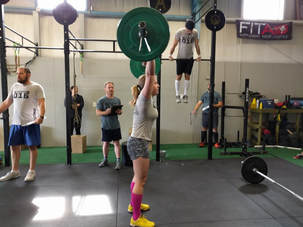 by Ryan Humphries, Co-Founder & Fitness Coach, Axistence Athletics Long ago, in a galaxy far, far away, before there were AMRAPs, Rounds For Time, Girl and Hero WODs, there was a unique fitness principle. Some called it “Training” and others called it “Practice.” This principle was simple: if an individual wished to improve in a specific area, they would spend time practicing in that area – focusing solely on technique. Every so often, when appropriate, they would add intensity to those techniques, incorporating them into a workout or testing their improvement against a benchmark. Back then, practice was one thing. Competing, even against yourself, was wholly another. And the focus on constant rapid improvement has caused some problems.
"Intensity, when applied carefully and correctly, can produce desirable results. When applied incorrectly, it can really jack you up." Today, in many fitness centers around the globe, the practice-to-improve philosophy has been replaced by a more intensity, more gainz philosophy. Athletes are loading themselves heavier and heavier or going for higher and higher reps so they can have a better number on the whiteboard. I know what you’re thinking… Stop hating on CrossFit™! But unfortunately, this is not a CrossFit specific issue. Due to the popularity of High Intensity Interval Training (The current #1 fitness trend according to the ACSM) everyone is looking for the most effective way to take his or her fitness to the next level. And there’s a reason why intensity is all the rage. Intensity gets results! Research shows there is a cascade of positive hormonal responses from high intensity workouts, including but not limited to decreased body fat and increased muscle mass. You've seen and heard the success stories from P90X, Insanity, HIIT, CrossFit and Orange Theory. Intensity, when applied carefully and correctly, can produce desirable results. However, you may have also heard about rotator cuff tears, broken bones, bulging or ruptured disks and a number of other training related injuries due to intensity. When applied incorrectly, intensity can really jack you up. Here are a few words of advice. "If you haven’t actually practiced the movements enough to be proficient in them, then you have no business increasing the intensity." How to Get Better Results from High Intensity Training - Safely In order to know how to correctly apply intensity, we must first define it. For our purposes, we’re going to describe intensity as the total power output of a specific workout. Another way to say it is being able to do more work in less time. With that definition, we can increase intensity in the following ways. 5 Ways to Safely Increase Intensity in Your Workouts
By choosing any of the above options, we can increase the total power output of the workout, thereby increasing the intensity of that workout; something that can and should be done ONLY when the athlete is proficient in the technique. So practice good technique and practice often. Have a coach watch to ensure you're doing things correctly. Then, you may apply intensity. Learn more about the fitness philosophy here at Axistence.
0 Comments
Your comment will be posted after it is approved.
Leave a Reply. |
Our JournalOur coaches research and report on all things regarding fitness, adventure and the community within. Categories
All
|
Located in SE Denver1950 S. Quebec St.
Denver, CO 80231 Looking for a gym near Denver? We also serve Glendale, Aurora, Lowry, Virginia Village, Denver Tech Center, Cherry Creek, Indian Creek, Wash Park, Broadway, SOBO, and more.
|
|

 RSS Feed
RSS Feed





